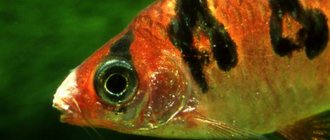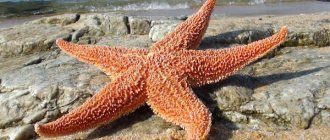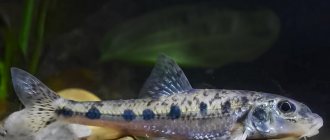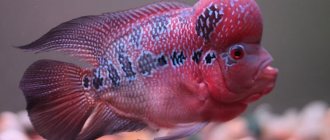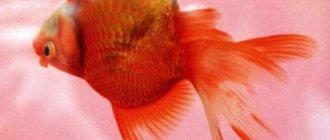Labyrinth
Gourami
Cockerel
Labyrinth fish are common among aquarists and are valued for their unpretentiousness and the absence of the need to organize additional aeration in the aquarium. Most representatives of labyrinths have bright colors and luxuriously shaped fins. They are also respected for their calm and peaceful disposition.
Labyrinth fish can live in small amounts of water. Representatives of the group are able to breathe external air by swallowing it through their mouths. In this case, the air should be warm and humid.
What is a labyrinth?
Everyone knows that fish breathe using gills. They pass water through this organ, taking oxygen from it. But some species differ from the general mass in the structural features of the body and the way they breathe. These are labyrinth fish that have an accessory respiratory apparatus.
In the process of evolution, some species developed a special organ, which is commonly called a labyrinth. This is a group of plates of bone tissue, which is densely intertwined with blood capillaries. The labyrinth organ is located on both sides of the head, near the gills. The presence of this organ in a large group of fish species allowed scientists to combine them into one group and call it Labyrinthidae.
In order for air to get into the labyrinth, the fish has to come to the surface and swallow air. It is this feature of the body that allows labyrinths to live in bodies of water with low oxygen levels. If there is clean water with a high oxygen content in the aquarium, but the fish do not have access to air, they will die.
It is important to remember that the adnexal respiratory apparatus is formed only 2-5 weeks after birth. Fry, unlike adults, need clean, oxygenated water.
Labyrinth fish have a calm disposition (with the exception of Siamese bettas), but can be aggressive during the spawning period. All species in this group prove to be excellent parents and take careful care of their offspring. The male is able to build a foam nest from air bubbles, which he places in the thick of algae. The structure is attached using mucus. This is where the eggs will be located.
Siamese cockerels during mating games.
All labyrinths have parental instincts. This is especially true for males. They take especially careful care of their offspring and jealously protect them.
Some representatives live exclusively in special water chemistry, but all labyrinth fish need warm, moist air above the surface of the water.
Marine Life Park, Singapore
The total volume of water is 45 million liters.
This giant aquarium, located on Sentosa Island, provides habitat for 100,000 marine animals, including rare stingrays, hammerhead sharks, Japanese spider crabs and other sea giants.
Dolphin Island, an integral part of the Marine Life Park, is home to the graceful bottlenose dolphins. There, visitors will receive an unforgettable interactive experience and the opportunity to meet dolphins up close in a safe environment for marine mammals and people. There will be a variety of dolphin interaction programs to choose from, including:
- interaction in shallow water, where guests will be waist-deep in water;
- interactions on the lagoon floor;
- swimming with dolphins in the depths of the lagoon.
And for those who are tired of watching underwater inhabitants, there are various attractions: water slides, hydromagnetic rockets and a giant “river of adventure” 620 meters long.
Currently, Sea Life Park is the second largest aquarium in the world.
Cockerel
This species tops the list of the most common and unpretentious labyrinth fish. Thanks to many years of selection, there are many forms on sale that differ not only in color, but also in the shape of their fins. There are about seventy breeds.
The most favorable conditions are a tank with a volume of 20 liters or more. It should have a lot of shelters and living plants. When combining with other species, it is important to take into account the similarity of water parameters and maintenance conditions.
The minimum volume of the reservoir is 5-10 liters. You need to install a filter in the aquarium and plant plants. Setting up the biobalance is very important, as this will simplify caring for your pet.
A distinctive feature of cockerels is their disgustingly quarrelsome character. Thanks to him, all types of cockerels are classified as so-called fighting cockerels. Male cockerels always fight among themselves when they meet. If a female is present nearby, then she too will be attacked and can be seriously injured. For this reason, cockerels are placed in a small aquarium one at a time.
If two males of the same size meet, they begin to demonstrate the size of their fins and the brightness of their color. After some time they start a fight. They open their mouths wide and bite the enemy's body. The male who has won does not allow the opponent to the surface of the water so that the latter cannot take a breath of air. As a result, the defeated cockerel dies.
You should know that two males will not get along in one body of water, even if the aquarium is very large. They will conflict over territory and females. Also, some males may show aggression towards the female during the spawning period if she is not to her liking.
In one aquarium, a betta will not get along with slow, small and veiled fish of other species. If a goldfish lives in a pond, then you shouldn’t put a cockerel there. Also, the species is incompatible with cichlids and other labyrinths. Cockerels simply eat small snails, and pinch off the whiskers of large ones.
You can live with speckled catfish, zebrafish, mollies, tetras and other active and nimble species that can run miles to defend their interests. It is important that the neighbors are as unlike the cockerel in appearance as possible.
First steps
Before you go to the store, you should consider some nuances. First of all, you should decide on the size and location of the container.
Weight
Even small aquariums weigh quite a lot.
It is necessary to take into account the mass of not only the container itself, but also the scenery, water and living inhabitants. A container with a volume of 100 liters weighs about 160 kg. Therefore, you should choose a stable, durable stand for any container and calculate how much weight the floors in the apartment can support.
Location
Direct rays of the sun should not fall on the aquarium for more than 2 hours a day. Otherwise, the walls of the container will become overgrown with unnecessary green algae, and the fish will suffer from overheating. Therefore, you need to install it away from windows.
There must be an electrical outlet next to the aquarium, since all the necessary devices mainly work from the network.
The aquarium should be placed in such a way that it is convenient to observe its inhabitants. It should not be located too high or low. Please note that most fish do not like to always be the center of attention. If you place an aquarium in a place that is always busy, its inhabitants will become nervous and upset. You shouldn’t go to the other extreme, placing the pond in a remote room where no one goes at all. This will make the fish too timid.
The ideal place is away from constant traffic, but in a regularly visited area.
Tips for Beginners Video that covers several important topics
Size
Beginners should choose a medium-sized container that is easy to maintain in a certain climate.
Aquariums that are too small quickly become dirty and require frequent cleaning, while large ones represent an entire ecosystem, the care of which requires experience and skill. For starters, containers with a volume of 80 to 130 liters are suitable.
Gourami
Under natural conditions, gourami live in stagnant water. It is not advisable to organize a fast flow in an aquarium. The optimal volume of the aquarium is from 50 liters. You can do without aeration, gourami do not need it, but for a general aquarium it should be. Oxidative processes play an important role in an artificial reservoir.
Appearance of a marbled gourami.
It is important to avoid high concentrations of nitrites, nitrates and ammonia. This can be disastrous for the inhabitants of the aquarium.
Gourami like dense grasses, but also need space to swim. Dark soil, bright lighting and the presence of snags are the factors necessary for the existence of labyrinth fish.
Gourami prefer a mature biological environment, where all the processes of biogeocenosis are established. The nitrogen cycle should work like clockwork.
This species is considered peaceful and gets along well with loaches, thorns and other calm species. It is better not to house swordtails and barbs.
Compatibility chart of gouramis with other aquarium inhabitants.
Subspecies and breeds of gourami:
Honey
Representatives of the breed are small in size. The color is golden or red. Keep in pairs or groups. The volume of the aquarium is 40 liters with a large number of live plants. Gets along well with calm fish.
Pearl
The fish have an unusual color. There are many spots on the silver-violet background. Pearl gourami grows up to 12 cm. It is better to keep these fish in small schools with a predominant number of females. Get along with peaceful species.
Dwarf
The appearance is slightly reminiscent of a betta, only the fins are slightly smaller. Also, the dwarf gourami cannot boast of bright colors. These unpretentious fish do not grow more than three to four centimeters and prefer to live in schools. They prefer species aquariums with plenty of hiding places.
Marble
An artificially bred breed valued for its bright color. There are many dark spots on the silver background. Representatives of the breed reach 13 cm in length. Compatible with fish with the same character. Loves abundant vegetation.
Description and habitat
Compared to other wild fish, the body length of barbs is considered to be of medium size - 5-30 cm. Barbels are schooling peaceful fish that are constantly moving: they chase each other, burrow, hide and unexpectedly jump out, they like to tease others. Barbs are not demanding when it comes to keeping fish, so it is easy for them to adapt to new conditions. The habitats of wild fish are China, Africa and Southeast Asia. Some species introduced into the waters of Colombia, the USA, Singapore and Australia have successfully taken root there. In these places, large, cheerful flocks of barbs are found in slow-moving rivers and streams, where there is a sandy bottom and a lot of vegetation.
Photo of the barb's native places
Appearance
The body of the barbel is elongated and slightly elongated, the front part is pointed. The tail is formed by two blades. A fish with developed pharyngeal teeth, which are not present on the jaws. Some species have antennae, adding originality to the varied colors. There are types of barbs of one color or with two shades, with spots or marked with stripes running along the body or across. Each species has its own color.
Lyalius
A small fish 5-6 cm long. The minimum volume of the aquarium is 20 liters. If you keep a flock, the volume of the reservoir should reach 50 liters.
Lalius are fish that are not recommended for beginners. They are very shy and suspicious. Stress causes illness.
The nitrogen cycle must be established in the reservoir. Content temperature + 27 C0. The water is soft and slightly acidic, pH less than 7. Only under such conditions the risk of disease is reduced to a minimum.
It is important to place a large number of plants and create shaded areas. It is good if plants such as riccia, duckweed or pistia float on the surface of the water.
You can keep several males in one pond, provided there are a sufficient number of females and plenty of space.
National Aquarium, USA
The total capacity is 8.3 million liters of water.
The National Aquarium in Baltimore, Maryland is one of the largest and most famous aquariums in the United States. It was opened in 1981 and since then has welcomed 1.5 million people annually.
It is home to 20,000 fish, birds, amphibians, reptiles and marine mammals of various species. There is a shark alley, an aquarium with dolphins where you can watch them learn and play, and many other interesting places.
An interesting part of this aquarium is the level that simulates the Amazon rainforest. It includes two above-ground bird-watching platforms and a cave with various glass displays of reptiles, amphibians and terrestrial arthropods.
Macropod
It has a long, large body that reaches 10 cm. A three-centimeter tail visually lengthens the fish. The color is rich olive or blue. Breeders have created many breeds that differ only in color. Males are brighter in color, females are more modest. Macropods live in an aquarium for up to 5 years.
A 40 liter tank is enough to keep one boy and two girls. They can jump out of the water, so a cover is necessary. A large aquarium can contain several pairs. Does not tolerate loneliness well and begins to attack representatives of other species.
Different color variations of macropods can be mixed with each other.
Macropods are able to get along with gouramis, barbs, mollies, swordtails and other calm fish. You should not house with species that have veil fins, as well as angelfish, discus, neons, and telescopes.
uShaka Marine World, Durban, South Africa
The total volume of water is 17.5 million liters.
It is one of the largest water parks in the world and the most popular marine theme park in South Africa, offering a world of water rides, dolphin, seal and penguin shows, swimming with sharks and many other attractions.
One of the most impressive exhibits is the giant jaw of Carcharodon, the largest shark in the world.
uShaka Marine World is built in an original style and looks like an old ship. At the same time, it has several modern restaurants, souvenir shops and cafes.
Another interesting “feature” of this aquarium is the “abandoned” steamship, and not a fake one, but a real one. The creators of the park were able to fit it into the territory so skillfully, as if the steamship had always been in this place.
Ctenopoma leopardum
The leopard coloring of the fish helps it hide among the plants. Ctenopoma grows up to 15-20 cm. For this reason, representatives of the species should not be settled in a reservoir of less than 100 liters. It is also important to cover the aquarium with glass or a lid. This is due to the fact that the fish can take a breath of cold air and get sick.
Ctenopoma prefers moderate lighting, abundant vegetation and the presence of darkened areas. It is advisable to place driftwood, create grottoes and other secluded places where the fish can hide and sleep.
Ctenopoma is a nocturnal predator, but prefers only small fish. If the inhabitants of the aquarium are the same or larger in size, then she simply will not pay attention to them.
It cannot fully exist if there is no filter.
For reproduction, the male creates a foam nest. He carefully looks after the eggs, but if disturbed, he immediately begins to scatter the eggs and stops all care for the future offspring.
Cube Oceanarium, China
The total volume of water is 11 million liters.
One of the youngest aquariums in the world celebrated its “birth” in 2015. But, despite such a young age, it is famous for its large number of “guests” (33,000 creatures, including the world’s largest jellyfish). And also the world's largest aquarium window, 39.65 meters wide and 8.3 meters high.
The pride of the Chinese aquarium are two whale sharks. But if you're not interested in these gentle giants, you'll always find a show to enjoy. After all, the Cube Oceanarium features exhibits from warm and cold waters, from the Pacific Ocean to the Amazon and the Northern Arctic.
Does a labyrinth aquarium really require no equipment?
Labyrinth fish can live in water without oxygen because they breathe outside air. For this reason, it is somewhat easier to equip an aquarium for them than for other species. But this does not mean that the reservoir does not require equipment and favorable conditions.
Rules for setting up an aquarium for labyrinths:
- First of all, the aquarium must be covered with a lid, but loosely - for air circulation. All types of labyrinth fish come to the surface and swallow air. It must be moist and warm so that the fish does not get cold. Also, some representatives of labyrinths have the habit of jumping out of the water and may find themselves outside the reservoir.
- There may be gravel or fine sand at the bottom of the tank. If you plan to place plants, it is better to use soil with sufficient nutrients.
- Many species prefer to hide in shelters. This makes them feel safe and calm. These can be thickets of algae, artificial caves and grottoes, and driftwood of natural origin. It is important to place plants in the aquarium that reproduce quickly and will float on the surface of the water, such as duckweed.
- For most fish, you can use settled tap water, but some fish prefer soft and acidified water.
- Labyrinth fish live in tropical climates. For this reason, the water temperature should not fall below +26 C0. They also prefer "old water" and frequent changes can lead to fighting. To calm the inhabitants of the aquarium in such a situation, it is necessary to reduce the temperature. The table below shows average data on water quality for labyrinths.
Volume of water (liters per 1 individual) Temperature (°C) Acidity (pH) Hardness (dGH) depending on the type 23-28 5,5-8 5-15 - You can do without a filter and compressor. You still need to filter the water, but models with the lowest power ratings are suitable. Representatives of the group do not tolerate fast currents well. The filter outlet should be directed towards the wall of the aquarium. Aeration is needed if there are fry in the aquarium. For up to three weeks they breathe oxygen contained in the water.
- A feeder is not needed for labyrinths.
Labyrinth fish die if ammonia, nitrates and nitrites accumulate in the aquarium. These are poisons that have a negative effect on all living organisms. To prevent a catastrophe, it is worth regularly testing the water and bringing it back to normal if the indicators increase.
Labyrinth fish require care and attention, but more than pay the bills with their striking appearance, curious behavior and hardy character.
Fish can die not only from poisons, but also from stress. This happens if the fish lives in a small aquarium. Some species are schooling, and if a fish cannot live alone, it dies. Also, aggressive neighbors often affect the emotional state.
It must be remembered that when transporting any species of labyrinth fish, pure oxygen cannot be pumped into the bag. This can cause respiratory burns and death.
Keeping and breeding labyrinth fish is simple and does not require much effort. It is important to provide pets with the necessary conditions and to prevent an increase in the concentration of toxic substances in the aquarium.
Dubai Aquarium, UAE
The total volume of water is 10.5 million liters.
In the UAE they love entertainment that has the prefix “greatest”, “largest”, “most amazing”, etc. So the Dubai Aquarium is one of the ten largest and most famous aquariums in the world. It also has one of the longest and tallest acrylic viewing panels in the world.
Dubai Aquarium is home to 33,000 aquatic animals (from crocodiles to colorful tropical fish) and has the world's largest collection of sand tiger sharks.
This aquarium regularly hosts presentations where you can learn more about the inhabitants of rivers, seas and oceans. Popular sessions include feeding sharks and crocodiles, as well as short presentations at the otter, piranha and penguin exhibits.
Chimelong Ocean Kingdom, China
The total volume of water is 48.7 million liters.
The largest aquarium in the world is located in China, in the city of Zhuhai. A grandiose oceanarium with almost 49 million liters of water.
Moreover, this theme park holds the record not only for size, but also for the size of the underwater observation dome. And it is listed in the Guinness Book of Records for the world's largest aquarium tank.
Chimelong Ocean Kingdom is also known for its great entertainment for families, with thrilling rides, circus animal shows and fireworks in the evenings.


